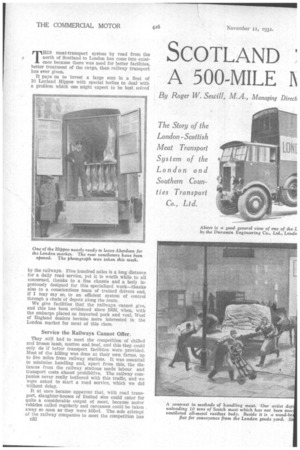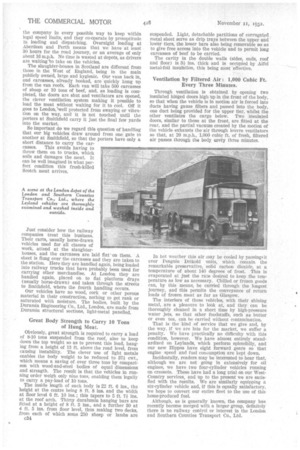SCOTLAND ' A 500-MILE 0 LONDON EAT SERVICE
Page 74

Page 75

Page 76

If you've noticed an error in this article please click here to report it so we can fix it.
By Roger W. Sewill, M.A., Managing Direct(
London and Southern Counties Transoort Co., Ltd.
The Story of the London-Scottish Meat Transport System of the London and Southern Counties Transport Co., Ltd. Hygienic Handling, together with Efficient Service, Makes the Leyland Fleet a Successful Competitor to Rail Transport
THIS meat-transport system by road from the north of Scotland to London has come into existence because there wasneed for better facilities, better treatment of the cargo, than railway transport has ever given.
It pays us to invest a large sum in a fleet of 10 Leyland Hippos with special bodies to deal with a problem which one might expect to be best solved by the railways. Five hundred miles is a long distance for a daily road service, yet it is worth while to all concerned, thanks to a fine chassis and a body ingeniously designed for this specialized work—thanks also to a conscientious team of trained drivers and, if I may say so, to an efficient system of control through a chain of depots along the route.
We give facilities that the railways cannot give, and this has been evidenced since 1926, when, with the embargo placed on imported pork and veal, West of England dealers became more interested in the London market for meat of this class.
Service the Railways Cannot Offer.
They still had to meet the competition of chilled and frozen lamb, mutton and beef, and this they could only do if better transport facilities were provided. Most of the killing was done at their own farms, up to five miles from railway stations. It was essential to minimize handling and, apart from this, the distances from the railway stations made labour and transport costs almost prohibitive. The railway companies never really bothered with this traffic, and we were asked to start a road service, which we did without delay.
It at once became apparent that, with road transport, slaughter-houses of limited size could cater for quite a considerable output of meat, because motor vehicles called regularly and carcasses could be taken . away so soon as they were killed. The sole attempt of the railway companies to meet the competition has c32
been by reducing rates, figures as low as II. 10s. per ton below the road rate being quoted, and the fact that they are still losing more traffic to the road proves the advantage of our methods. In six years, for all the railway propaganda to the contrary, 110 appreciable part of the traffic has been recovered by the use of lift-van bodies.
We started by serving Dorset, and the business extended to Somerset, Devon and Cornwall, so that now we have two or three vehicles coming nightly from Cornwall, besides a dozen more from the nearer counties, solely for meat and market produce. I think it will not be denied that road-carried meat is fetching id. per lb. more in the Smithfield Market.
The Scottish service was a logical development, -the elimination of handling being a great asset, whilst there are other advantages .also. Until we started, deliveries to the Scottish railway stations on Saturdays had to be finished before noon. We offered later times of collection from such places as Aberdeen and Perth, and could even make collections very early on Sunday mornings at towns near the Border. This proved most useful.
Chain of Depots on 500-mile Route. We started at the beginning a this year, and we now operate daily from Aberdeen, Perth and Border towns. So as to meet the requirements of regulations concerning drivers' hours we have established properly equipped depots at •Perth, East Riggs (near Gretna), Berwick and Doncaster, thus following the system adopted on our West-Country routes, where we have depots at Salisbury, Exeter, and in Cornwall. Drivers are exchanged at the depots, and this gives the advantage that, at each individual slaughter-house, the same driver handles the collection every day, saving time and trouble. A driver arriving at a depot from the north takes back a north-bound motor.
Our senders all realize that it is essential to help c33
the company in every possible way to keep within legal speed limits, and they co-operate by promptitude in loading and dispatching. Overnight loading at Aberdeen and Perth means that we have at least 30 hours for the road journey, or an average of only about 16 m.p.h. No time is wasted at depots, as drivers are waiting 'to take on the vehicles.
The slaughter-houses in Scotland are different from those in the West of England, being in the main publicly owned, large and hygienic. Our vans back in, and carcasses, already booked, are quickly hung up from the van roofs. .Each van will take 500 carcasses of sheep or 10 tons of beef, and, as loading is completed, the doors are shut and ventilators are opened, the clever ventilation system making it possible to load the meat without waiting for it to cool. Off it goes to London,lwell protected from swaying or vibration on the way, and it is not touched until the porters at Smithfield carry it just the final few yards into the market.
So important do we regard this question of handling that our big vehicles draw around from one gate to another at Smithfield, so that the porters have only a short distance to carry the car casses. This avoids having to throw them on to trucks, which soils and damages the meat. It can be well imagined in what perfect condition this fresh-killed Scotch meat arrives.
Just consider how the railway companies treat this business. Their carts, usually horse-drawn vehicles used for all classes of work, attend at the slaughterhouses, and the carcasses are laid flat' on them. A sheet is flung over the carcasses and they are taken to the station. Here they are. handled again, being loaded into railway trucks that have probably been used for carrying other merchandise. At London they are handled again, placed on to flat platform drays (usually horse-drawn) and taken through the streets to Smithfield, where the fourth handling occurs.
Our vehicles have no wood, cork or other porous material in their construction, nothing to get rank or saturated with moisture. The bodies, built by the Duramin Engineering Co., Ltd., London, are made from Duramin structural sections, light-metal panelled.
Great Body Strength to Carry 10 Tons of Hung Meat.
Obviously, great strength is required to carry a load of 8-10 tons suspended from the roof, also to keep down the top weight so as to prevent this load, hanging from a height of 13 ft. above the road level, from causing instability. The clever use of light metals enables the body weight to be reduced to 371 cwt., which means a saving of over three tons by comparison with wood-and-steel bodies of equal dimensions and strength. The result is that the vehicles in running order weigh only nine tons, enabling them legally to carry a pay-load of 10 tons.
The inside length of each body is 22 ft. 6 ins., the height at the centre being 8 ft. 8 ins, and the width at floor level 6 ft. 10 ins.; this tapers to 5 ft. 73 ins. at the roof arch. Thirty duralumin hanging bars are fitted at a height of 8 ft. 5 ins., and a further 30 at 4 ft. 5 ins, from floor level, thus making two decks, from each of which some 250 sheep or lambs are c34 suspended. Light, detachable partitions of corrugated metal sheet serve as drip trays between the upper and lower tiers, the lower bars also being removable so as to give free access Into the vehicle and to permit long carcasses of beef to be carried.
The cavity in the double walls (sides, ends, roof and floor) is 3/ ins, thick and is occupied by Alfol metal-foil insulation, this being most effective.
Ventilation by Filtered Air: 1,000 Cubic Ft. Every Three Minutes.
Through ventilation is obtained by opening two insulated hinged doors high up in the front of the body, so that when the vehicle is in motion air is forced into duets having gauze filters and passed into the body, one duct being provided for the upper tier, whilst the other ventilates the cargo below. Two insulated doors, similar to those at the front, are fitted at the rear, and the partial vacuum created by the motion of the vehicle exhausts the-air through louvre ventilators so that, at 20 m.p.h., 1,000 cubic ft. of fresh, filtered air passes through the body every three minutes.
In hot weather this air may be cooled by passing' it over Penguin Drikold units, which contain the remarkable preservative, solid carbon dioxide, at a temperature of about 140 degrees of frost. This is evaporated at just the rate desired to keep the temperature as low as necessary. Chilled or frozen goods can, by this means, be carried through the longest journey, and this permits the conveyance of return loads of frozen meat as far as Glasgow.
The interiors of these vehicles, with their shining metal, are a pleasure to look at, and they can be thoroughly cleaned in a short time by high-pressure water jets, so that other foodstuffs, such as butter or even tea, can be carried without contamination.
That is the kind of service that we give and, by the way, if we are late for the market, we suffer_ a penalty. We have practically no difficulty with this condition, however. We have almost entirely standardized on Leylands, which perform splendidly, and our new Hippos have eight forward gears so that engine speed and fuel consumption are kept down.
Incidentally, readers may be interested to hear that, although we are not going in extensively for oil engines, we have two four-cylinder vehicles running on creosote. These have had a long trial on our WestCountry services, and up to the present we are satisfied with the results. We are similarly equipping a six-cylinder vehicle and, if this is equally satisfactory, we hope to convert our entire fleet to the use of this home-produced fuel.
Although, as is generally known, the company has recently become merged with a larger group, definitely there is no railway control or interest in the London and Southern Counties Transport Co., Ltd.




















































































































































